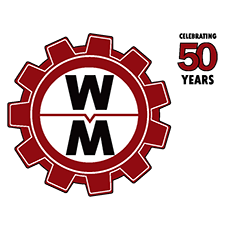When it comes time to decide how to produce a part, operators will find themselves faced with a number of options. Often one of the most challenging is whether you should use a punching or a laser cutting machine. If the part you’re making features holes or perimeters, both can produce those types of results. But which will be right for your job?
We’ve put together this guide to help you determine if punching or laser cutting makes more sense for you:
1. Evaluate Your Operating Costs
 As an operator, factors you need to consider about the projects you’ll be tackling include:
As an operator, factors you need to consider about the projects you’ll be tackling include:
- Production Speed: Punching machines are able to cut holes more quickly than laser cutters. If you’re working on a part with a lot of holes – say 30,000 – using something like a cluster punch can dramatically increase throughput.
- Level of Intricacy: Laser cutting machines are ideal for creating shapes with a number of small features, curves, and details.
- Batch Sizes: Punches are best suited for dealing with larger batches, since they take longer to get ready. Laser cutters, by comparison, can be set up more quickly, which is especially useful if you need to switch between jobs to make smaller batches.
Whether working with laser cutters or punches, the best way to streamline operations is by maintaining detailed records, creating operator-centric workstations, keeping materials close at hand, using shuttle tables, building modular fixtures, and running similar jobs back to back.
2. Analyze Parts
The general rule of thumb is that punches are best for working with thicker materials, while laser cutters are better for thinner materials.
Operators should also take into account variables like:
- Size: The size of the machine and thickness of the material together should dictate the tools used. With punches, the accepted guideline is to follow a 1-to-1 ratio.
- Shape: Rectangular parts are ideal for punching, while laser cutters are better for creating pieces with bigger openings or irregular shapes.
- Forming Capabilities: Parts with large louvers or countersinks needing taping are ideal for punching. Features like these can be added in one operation with one setup, reducing processing time and the risk of error.
3. Use the Right Tooling
 With punches, the key is flexibility – specifically whether or not the machine can rotate the tool 360 degrees, which will expand the number of punched patterns that can be produced without additional tooling setup. It also cuts down on scrap creation, as parts can be nested at any angle on the sheet for efficient material utilization. Other punch features and tools to look for include handling and sorting tools like chute drops and automatic unloading devices, streamlining the process especially for larger batches.
With punches, the key is flexibility – specifically whether or not the machine can rotate the tool 360 degrees, which will expand the number of punched patterns that can be produced without additional tooling setup. It also cuts down on scrap creation, as parts can be nested at any angle on the sheet for efficient material utilization. Other punch features and tools to look for include handling and sorting tools like chute drops and automatic unloading devices, streamlining the process especially for larger batches.
With laser cutting machines, flexibility is built in. They’re adaptable at high speeds, with new technology accelerating up to 10,000IPM. You don’t need to add additional optics unless cutting thick materials, and you don’t need to worry about changing oil or filters.
That being said, laser cutters can sometimes be too quick for manual removal. It often makes sense to invest in skeleton and part removal tools, automated sheet delivery, and technologies that separate parts to keep pace with a laser cutter’s speed.
Ultimately, what really matters is choosing the best machine for the job at hand that will let you create parts in the most efficient, safe, and cost-effective way.
Westway Machinery is proud to provide our customers with a variety of laser cutting and punching machines from trusted suppliers like MAZAK and Fabmaster. Contact us today to find out more about our products and services!
Like this post? You’ll also enjoy:

